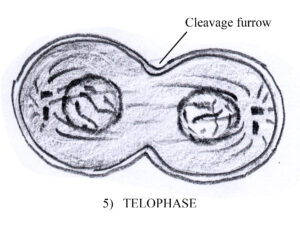Cell division
Cell division is the process by which a cell reproduces itself. Most cells of the human body undergo cell division. There are two types of cell division, mitosis and meiosis. In this process there is formation of two identical daughter cell.
Mitosis
· In mitosis, one cell with the diploid number of chromosomes (46 number) divides into two identical cells, each with the diploid number of chromosomes.
· This production of cell is necessary for growth and repair of tissues.
· The process of DNA replication enables each chromosome (in the form of chromatin) to make a copy of itself.
· The time taken for the conversion of duplicate is called interphase or resting phase
Interphase
· During interphase the cell replicates its DNA as well as produces additional set of organelles or cytosolic components.
· It is a high metabolic activity stage.
· The interphase consists of three phases:
1. G1 phase
2. S phase
3. G2 phase

G1 phase
· The G1 phase is the interval between the mitotic phase and the S phase.
· This stage is the metabolically active and it replicate most of its organelles and cytosolic components but does not replicates its DNA.
· It takes 8-10 hours to complete G1 phase. Some muscle cells and nerve cells do not reproduce themselves, such type of cells are in G0 phase. If the cell die, their function also lost.
S phase
· The interval between G1 and G2 and it is lasts about 8 hours. In this stage DNA replication occur and two identical cells are formed.
G2 phase
· The G2 phase is the interval between the S phase and the mitotic phase. It lasts 4 to 6 hours.
· In this stage complete replication of centrosome occur and also protein and enzyme synthesis are continues for cell division.
· During DNA replication in S phase, its helical structure partially uncoils, and the two strands separate at the points where hydrogen bonds connect base pairs.
· Each exposed base of the old DNA strand then pairs with the complementary base of a newly synthesized nucleotide.
· A new DNA strand is taking shape due to the formation of chemical bonds between neighboring nucleotides.
· The uncoiling and complimentary base pairing continues until each of the two original DNA strands is joined with a newly formed complementary DNA strand.
· The original DNA molecule has become two identical DNA molecules.
Mitotic phase
· The mitotic phase results in the formation of two identical cells, which consist of a nuclear division (mitosis) and cytoplasmic division (cytokinesis). The mitotic phase is divided into four phases:
1. Prophase
2. Metaphase
3. Anaphase
4. Telophase
Prophase
· In the earlier of this phase the chromatin becomes tightly coiled or condense into chromosomes that are easier to see under microscope. This process helps to prevent entangling of the long DNA strands.
· Each prophase chromosome consists of a pair of identical strands called chromatids. The two chromatids are joined to each other at the centromere.
· At the outside of each centromere is a protein complex known as the kinetochore.
· Later in prophase, tubulins in the pericentriolar material of the centrosomes start to form the mitotic spindle (assembly of microtubules that attach to the kinetochore).

· Then the mitotic spindle moves to opposite pole and separate the chromatids. The nucleolus disappears and the nuclear envelope breaks down.
Metaphase
· The chromatids align on the centre of the spindle, attached by their centromeres.

Anaphase
· The centromeres separate, and one of each pair of sister chromatids (termed as chromosome) migrates to each end of the spindle as the microtubules that form the mitotic spindle contract.
· It appears “V” shaped.

Telophase
· It is the last phase of mitosis, the mitotic spindle disappear, the chromosomes uncoil and the nuclear envelope reforms.

Cytokinesis
· Cytoplasmic division; contractile ring forms cleavage furrow around center of cell, dividing cytoplasm into separate and equal portions.


Hi….!! My name is Smrutiranjan Dash, From Odisha, India. Professionally I am Assistant Professor at The Pharmaceutical College, Barpali, Odisha, department of Pharmacology.
